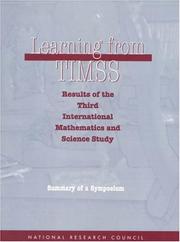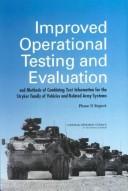| Listing 1 - 10 of 41 | << page >> |
Sort by
|
Book
ISBN: 0309465389 0309465400 Year: 2017 Publisher: Washington, District of Columbia : The National Academies Press,
Abstract | Keywords | Export | Availability | Bookmark
 Loading...
Loading...Choose an application
- Reference Manager
- EndNote
- RefWorks (Direct export to RefWorks)
"The environment for obtaining information and providing statistical data for policy makers and the public has changed significantly in the past decade, raising questions about the fundamental survey paradigm that underlies federal statistics. New data sources provide opportunities to develop a new paradigm that can improve timeliness, geographic or subpopulation detail, and statistical efficiency. It also has the potential to reduce the costs of producing federal statistics"--Provided by publisher.
Information retrieval. --- United States --- Statistical services. --- Data retrieval --- Data storage --- Discovery, Information --- Information discovery --- Information storage and retrieval --- Retrieval of information --- Documentation --- Information science --- Information storage and retrieval systems
Book
ISBN: 030946532X 0309465303 Year: 2017 Publisher: Washington, District of Columbia : The National Academies Press,
Abstract | Keywords | Export | Availability | Bookmark
 Loading...
Loading...Choose an application
- Reference Manager
- EndNote
- RefWorks (Direct export to RefWorks)
Agricultural estimating and reporting --- Information resources. --- United States.

ISBN: 0309059755 0585144494 9780585144498 0309059445 9780309059442 0309075181 9780309075183 Year: 1997
Abstract | Keywords | Export | Availability | Bookmark
 Loading...
Loading...Choose an application
- Reference Manager
- EndNote
- RefWorks (Direct export to RefWorks)
Mathematics --- Science
Book
ISBN: 0309456533 030945655X Year: 2017 Publisher: Washington, District of Columbia : The National Academies Press,
Abstract | Keywords | Export | Availability | Bookmark
 Loading...
Loading...Choose an application
- Reference Manager
- EndNote
- RefWorks (Direct export to RefWorks)
"In the coming years, complex domestic and international environments and challenges to national security will continue. Intelligence analysts and the intelligence community will need access to the appropriate tools and developing knowledge about threats to national security in order to provide the best information to policy makers. Research and knowledge from the social and behavioral sciences (SBS) can help inform the work of intelligence analysis; however, in the past, bringing important findings from research to bear on the day-to-day work of intelligence analysis has been difficult. In order to understand how knowledge from science can be directed and applied to help the intelligence community fulfill its critical responsibilities, the National Academies of Sciences, Engineering, and Medicine will undertake a 2-year survey of the social and behavioral sciences. To launch this discussion, a summit designed to highlight cutting-edge research and identify future directions for research in a few areas of the social and behavioral sciences was held in October 2016. This publication summarizes the presentations and discussions from the summit"--Publisher's description.
National security --- Behavioral assessment --- United States.

ISBN: 1280246669 9786610246663 0309528178 9780309528177 0309091020 9780309091022 0309166675 Year: 2004 Publisher: Washington, D.C. : National Academies Press,
Abstract | Keywords | Export | Availability | Bookmark
 Loading...
Loading...Choose an application
- Reference Manager
- EndNote
- RefWorks (Direct export to RefWorks)
Tanks (Military science) --- Armored vehicles, Military --- Armored military vehicles --- Combat vehicles --- Vehicles, Armored (Military science) --- Mechanization, Military --- Vehicles, Military --- Testing. --- Evaluation.
Book
ISBN: 0309317207 0309317185 9780309317184 9780309317177 0309317177 Year: 2015 Publisher: Washington, DC : National Academies Press,
Abstract | Keywords | Export | Availability | Bookmark
 Loading...
Loading...Choose an application
- Reference Manager
- EndNote
- RefWorks (Direct export to RefWorks)
United States. --- Recruiting, enlistment, etc. --- United States --- Armed Forces
Book
ISBN: 0309314771 0309314755 Year: 2015 Publisher: Washington, District of Columbia : The National Academies Press,
Abstract | Keywords | Export | Availability | Bookmark
 Loading...
Loading...Choose an application
- Reference Manager
- EndNote
- RefWorks (Direct export to RefWorks)
A high percentage of defense systems fail to meet their reliability requirements. This is a serious problem for the U.S. Department of Defense (DOD), as well as the nation. Those systems are not only less likely to successfully carry out their intended missions, but they also could endanger the lives of the operators. Furthermore, reliability failures discovered after deployment can result in costly and strategic delays and the need for expensive redesign, which often limits the tactical situations in which the system can be used. Finally, systems that fail to meet their reliability requirements are much more likely to need additional scheduled and unscheduled maintenance and to need more spare parts and possibly replacement systems, all of which can substantially increase the life-cycle costs of a system. Beginning in 2008, DOD undertook a concerted effort to raise the priority of reliability through greater use of design for reliability techniques, reliability growth testing, and formal reliability growth modeling, by both the contractors and DOD units. To this end, handbooks, guidances, and formal memoranda were revised or newly issued to reduce the frequency of reliability deficiencies for defense systems in operational testing and the effects of those deficiencies. Reliability Growth evaluates these recent changes and, more generally, assesses how current DOD principles and practices could be modified to increase the likelihood that defense systems will satisfy their reliability requirements. This report examines changes to the reliability requirements for proposed systems; defines modern design and testing for reliability; discusses the contractor's role in reliability testing; and summarizes the current state of formal reliability growth modeling. The recommendations of Reliability Growth will improve the reliability of defense systems and protect the health of the valuable personnel who operate them.
United States. --- United States --- Armed Forces --- Weapons systems.
Book
ISBN: 030945560X 0309455588 Year: 2017 Publisher: Washington, District of Columbia : National Academies Press,
Abstract | Keywords | Export | Availability | Bookmark
 Loading...
Loading...Choose an application
- Reference Manager
- EndNote
- RefWorks (Direct export to RefWorks)
"The development of character is a valued objective for many kinds of educational programs that take place both in and outside of school. Educators and administrators who develop and run programs that seek to develop character recognize that the established approaches for doing so have much in common, and they are eager to learn about promising practices used in other settings, evidence of effectiveness, and ways to measure the effectiveness of their own approaches. In July 2016, the National Academies of Sciences, Engineering, and Medicine held a workshop to review research and practice relevant to the development of character, with a particular focus on ideas that can support the adults who develop and run out-of-school programs. This publication summarizes the presentations and discussions from the workshop"--Publisher's description.
Book
ISBN: 0309391482 0309391466 Year: 2016 Publisher: Washington, D.C. : National Academies Press,
Abstract | Keywords | Export | Availability | Bookmark
 Loading...
Loading...Choose an application
- Reference Manager
- EndNote
- RefWorks (Direct export to RefWorks)
"The social cost of carbon (SCC) for a given year is an estimate, in dollars, of the present discounted value of the damage caused by a 1-metric ton increase in CO2 emissions into the atmosphere in that year; or equivalently, the benefits of reducing CO2 emissions by the same amount in that given year. The SCC is intended to provide a comprehensive measure of the monetized value of the net damages from global climate change from an additional unit of CO2, including, but not limited to, changes in net agricultural productivity, energy use, human health effects, and property damages from increased flood risk. Federal agencies use the SCC to value the CO2 emissions impacts of various policies including emission and fuel economy standards for vehicles, regulations of industrial air pollutants from industrial manufacturing, emission standards for power plants and solid waste incineration, and appliance energy efficiency standards. There are significant challenges to estimating a dollar value that reflects all the physical, human, ecological, and economic impacts of climate change. Recognizing that the models and scientific data underlying the SCC estimates evolve and improve over time, the federal government made a commitment to provide regular updates to the estimates. To assist with future revisions of the SCC, the Interagency Working Group on the Social Cost of Carbon (IWG) requested the National Academies of Sciences, Engineering, and Medicine complete a study that assessed the merits and challenges of a limited near-term update to the SCC and of a comprehensive update of the SCC to ensure that the estimates reflect the best available science. This interim report focuses on near-term updates to the SCC estimates"--
Carbon monoxide --- Carbon monoxide --- Economic aspects. --- Social aspects.

ISBN: 0309090598 9786610179459 1280179457 0309527112 9780309527118 9780309090599 0309089425 9781280179457 661017945X 0309182581 9780309182584 Year: 2003 Publisher: Washington : National Academies Press,
Abstract | Keywords | Export | Availability | Bookmark
 Loading...
Loading...Choose an application
- Reference Manager
- EndNote
- RefWorks (Direct export to RefWorks)
Electronic books. -- local. --- Labor laws and legislation, International. --- Labor policy. --- Human capital --- Urban poor --- Labor laws and legislation, International --- Business & Economics --- Labor & Workers' Economics --- City dwellers --- Poor
| Listing 1 - 10 of 41 | << page >> |
Sort by
|

 Search
Search Feedback
Feedback About UniCat
About UniCat  Help
Help News
News